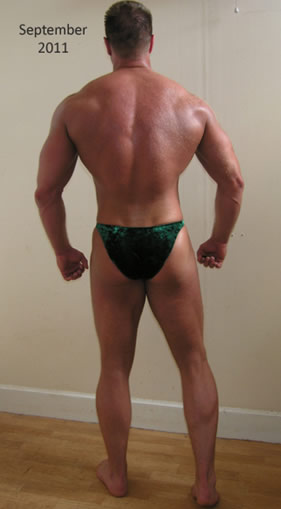By ‘Peagreen’
“The pain is just something you’ll have to learn to live with.” I’ve heard this phrase, not just once in my lifetime, but from the mouths of several different specialists over the years; from my late teens, all through my twenties and into my thirties.
I was roughly thirteen when I was first examined for a curvature of the spine: scoliosis. I can’t remember whether it was through the high diving club I was a part of or at school?
Maybe both. However, I was referred to a back specialist who promptly declared, taking him approximately all of 30 seconds, the severity of the cob angle (curvature) was low level and all I would need was regular check-ups as I grew to make sure it did not get any worse.
At seventeen I started to develop severe lower back pain and after consulting a specialist I was told the curvature was minimal and unchanged since first discovered but because of the length of my back I would always suffer.
I was given a weights routine to follow and warned to reduce my water skiing and badminton and to also cut down on my triathlon work, especially the running. Not something as a seventeen year old I believed was the best advice; I was given pain killers, patted on the head and once again shown the door. If pain was something I was going to have to learn to live with, then I would. The pills were consequently binned.
Several years later, I visited my cousin in Canada during a particularly hectic period of work. I needed the break and headed over. We were sat in a coffee shop and I was meeting his partner for the first time. We were chatting when she interrupted the conversation by asking me where the pain or discomfort I was feeling emanated from?
I obviously gave her a puzzled look to which she disclosed she was a Pain Therapist. She explained when pain persists after an injury or pathology has healed, and when medical science cannot identify the cause of pain, she was tasked with managing habitual sufferers.
She informed me that she could see I was in pain from my posture, the way I was seated and constantly shifted. Plus from the pain etched on my face, my cousin casually joked I just always looked like that.
She believed my back pain was possibly just a psychosomatic response to situations in my life, such as the stress of my job at that present time. I was a little sceptical but the idea did have merit. As we discussed the discomfort, it became apparent the times in my life I had suffered most, was during extreme stressful periods. Such as exams, messy break-ups, film deadlines, funerals, etc. She concluded my pain was more psychosomatic and more than likely not linked to the scoliosis in my back.
This small chat changed my perspective on my pain and the slight curvature, in honesty it more or less ceased overnight. However, the continuing discussions we had about pain and where it stems from were very interesting.
I cannot remember the exact words she used, so I will paraphrase somewhat, but the idea struck a chord with me from that very first discussion to this day: “the sufferer’s area in which the pain is felt is very often not the area in which the problem lies.
Finding the route cause, though, is the hard part; practitioners tend to treat the immediate pain and not the cause, such as chiropractors.” Unsurprisingly, I have never been a fan of them.
Last year, 2010, having had a break from training with the vain idea of competing and also because of ongoing health issues, eviction, unemployment and generally making pitiful excuses for myself, I decided to enter MuscleTalk’s Shape-Up Competition for motivation and to give myself the much needed kick up the arse.
After twelve weeks hard slog, I was feeling pretty pleased and posted the comparison pictures. Only at that point did I realise how pronounced the dipped shoulder I have had become. I had always been acutely aware of it but until those comparison pictures on MT I had never truly worried about it. I then decided I needed help.
If I was ever going to compete, I would either have to correct the problem or to learn to hide it.
MT’s 2010 September Shape-Up Competition pictures before and after. All pics are taken relaxed and without being pumped after a training session
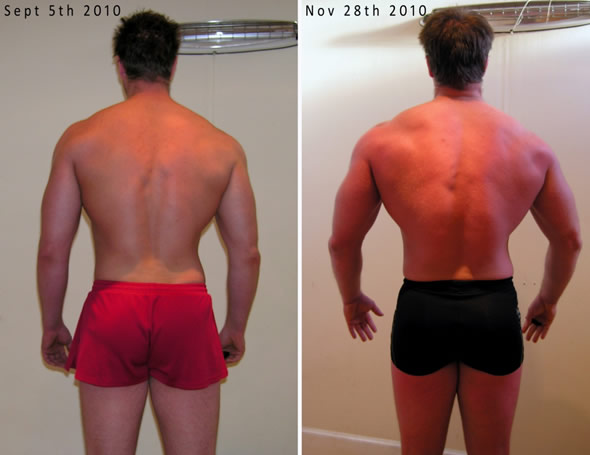
I decided to ask the knowledgeable people on MT for some advice and posted a thread about the problem, which not only spoke of my dipped shoulder but also worryingly, a cramping sensation that was frustratingly beginning to hinder every workout.
Between the many excellent answers from the MT members, I was drawn to two in particular: one from member Rachfit and the other from member Logic Fitness. Particularly Logic Fitness, as he also picked up on the fact my right hand lat was also lower, which I had never noticed before.
Damn it, something else to worry about! Both of their answers came from a biomechanics point of view and I had been interested in their particular methodology for a while after seeing one in action talk about the benefits of biomechanics at a seminar in Manchester.
I spoke to Logic Fitness, or specifically the man behind his online persona Michael Andreou, and realised he was based where I grew up. It was fate: I was driving home a few weeks after and decided to book in with him for an assessment.
In truth I was more than a little sceptical having been told since my early teens there was absolutely nothing that could be done but I had finally made the decision, after several false starts and bumps along the way I felt I was ready (body willing) to try again and step on stage to compete.
Therefore, I needed my body to look symmetrical, without having to seriously think about it or compensate. Secondly, with the aid of an expert, hopefully stop the pain I was getting throughout my workouts and continually.
I saw Michael in February 2011 for my first assessment, I’m sure he would be able to confirm how sceptical I truly was. However, I was instantly put at ease with his professionalism and friendliness: he really knew what he was talking about, which was just the kind of affirmation I needed.
During the assessment, I began to realise exactly how much pain I was training around and lived with, day to day. So many niggles which I tended to ignore (living with the pain) were seemingly connected.
Michael painstakingly took me through everything. He explained every little detail as to why he was manipulating me, ways in which I had not been pushed or pulled in years, in fact ever. I was in agony; the pain down my back was excruciating which registered in every grimace.
My shoulder felt like it wanted to explode but Michael gradually tweaked, assessed and analysed every minute pain throughout my entire body which I casually mentioned; it was thorough to say the least and I was extremely impressed.
According to Michael my pelvis was frozen which also had the knock on effect that the lower portion of my back had no movement whatsoever. To start with we needed to get this loss of motion back and for everything to be working as it should.
This meant instigating a number of exercises which would hopefully release the weak/frozen parts of my body and get the motion back to where it should be again.
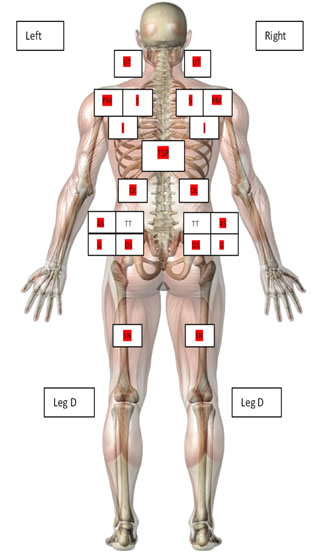
Michael showed me his report after the first assessment: red is bad! Everything in red indicated a biomechanical issue – which means my whole body was not great. At the time it felt like the diagram; every joint was in pain.
He emailed the details, plus the exercises for my continuing homework. I must admit I thought the exercises he demonstrated and recommended were rather strange and at the time I did not see their function.
Plus I felt a bit of an idiot doing them, especially in the gym but I decided to put my trust in Michael and incorporate them day to day. I commenced the exercises first thing every day after cardio and in the afternoon before I started a weights session.
The first two or three weeks were very alarming as I was in a lot of pain, plus my lifting seemed to change dramatically. I was completely thrown by the difference. I was unable to lift anything heavy.
My lifting dropped extensively which was incredibly off putting as my body started to adapt and change to the new routine and training symmetrically, as Michael insisted. I was a little disheartened by the whole experience but what I noticed over that first month was that the niggles and pains I had worked around for months, if not years, started to disappear.
My shoulder pain subsided and promptly ceased, which had caused discomfort for as long as I had lifted. For me this has been the biggest surprise and biggest benefit to my training in the last six months.
The cramping sensation which continually interrupted my weight sessions along the left side of my back also decreased. Occasionally it still twinges but not every session like it used to, which would cause sets to be disrupted or abandoned completely, while I tried to compensate or readjust my body around the pain (or give up entirely on a gym session).
All in all, I was very pleased with the progress I had made in a very short space of time.
Approximately six weeks after seeing Michael
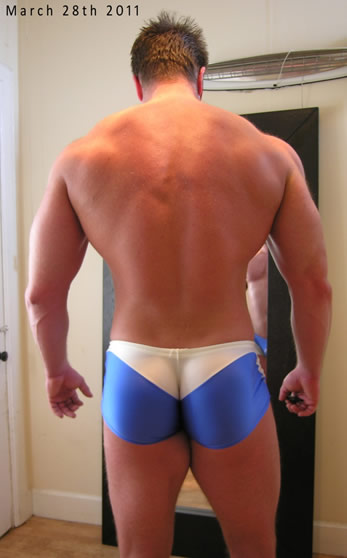
I went back to see Michael in June for a second assessment. Obviously he would like to have seen me at shorter intervals but the distance for me, from Scotland to the south coast was a bit difficult; however things are much more positive. My body is moving, I’m able to move the lower part of my spine and my pelvis is moving again too. Yes, I still have issues but the pain I spoke of, that I have lived with day to day throughout my entire adult life, has all but ceased.
The biomechanics issues I originally went to Michael with have not been totally eradicated, as shown by the second diagram. They have highlighted other areas to work on but with the continual support and (groan) extra exercises he has provided me with, plus a considerable set of new ones to improve my posture and rounded shoulders because my traps seem to be in a permanent state of spasm. The whole process for me has been highly enlightening and worth every penny.
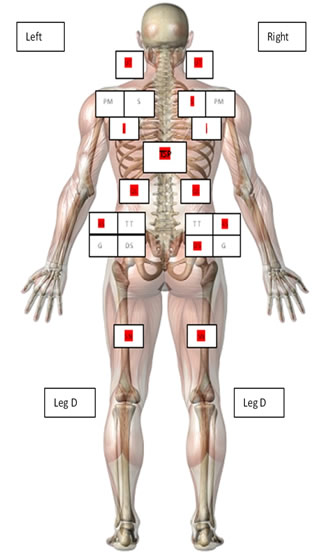
I went to Michael slightly cynical that biomechanics was all it was cracked up to be, but I have completely changed my mindset, along with it, implementing a few exercises into my routines have reduced the aches and pains that continually plagued and hindered my training.
I am not completely ready mentally to step on stage yet (watch this space) but outwardly I’m getting there and the confidence, after so many setbacks, is once again gaining momentum. I hope to at least tread the boards before I become a senior.
“The pain is just something you’ll have to learn to live with?” – I only hope the alleged specialists I have been prodded by over the years will read this and realise their own specialism is possibly their downfall.
I know biomechanics is a relatively new field but in less than six months Michael has done more for the constant pain in my back and shoulders, the symmetry in my body and my day to day training, which was in truth becoming a chore, than anyone. Ultimately though, putting my trust in someone to help has really been beneficial to me on so many levels.
I can truly recommend to anyone who has issues, shoulder, back or otherwise, to go for a biomechanics assessment: you won’t regret it at all. I haven’t.
Almost a year since I started MT’s Shape Up Competition, after dieting and changed training habits, this is my back and body structure
